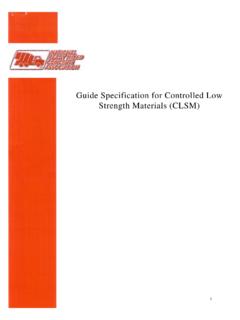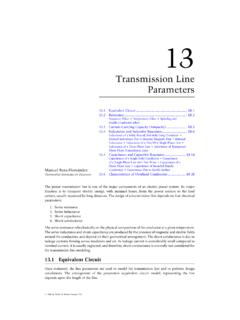Transcription of Guide Specification for Controlled Low Strength Materials ...
1 1 Guide Specification for Controlled Low Strength Materials (CLSM) Guide Specification for Controlled Low Strength Materials (CLSM) 2 SCOPE This Specification covers Controlled Low Strength Materials , CLSM, manufactured and delivered to a purchaser in a freshly mixed and unhardened state. Based on the application, the Engineer shall specify one or more of the performance properties and material parameters from tests listed in Table Table : Performance & Material Test Properties Performance Test Property Property Corrosive Resistance pH, Resistivity, Permeability Flowability Flow Excavatability Unconfined Compressive Strength Permeability Water Permeability Air Content In-Place Density Plastic Unit Weight Strength Unconfined Compressive Strength California Bearing Ratio Penetration Resistance Ball Penetration Thermal Conductivity Plastic Unit Weight Moisture Conductivity Thermal Transmittance (U) Thermal Insulating Value Plastic unit Weight Moisture Content Thermal Resistance Value (R-Value)
2 Acidity/ Alkalinity pH This Specification is intended to serve as a Guide to engineers, architects and specifiers that have interest in specifying Controlled low Strength Materials (CLSM), commonly called flowable fill. It covers the selection of the raw Materials and their proportions to produce the required performance properties, quality control and acceptance procedures, and procedures for measuring, batching, mixing and delivery, and placement. It is the responsibility of the specifying authority to identify performance characteristics required for the project.
3 The material supplier should be permitted to design the CLSM mixture using readily available Materials to meet the job performance requirements. The Guide is presented in a format similar to that used by the American Association of State Highway and Transportation Officials, AASHTO, for specifying Materials of construction. The specifier may cite the Guide in the contract documents or re-write the Guide into contract documents using all or parts of the provisions. The specifier may supplement the Guide provisions as needed. The specifiers' provisions will supercede the requirements of this Guide Specification .
4 The Guide Specification is not intended to address all applications of CLSM. Principal applications covered by this document include but are not limited to: General construction backfill and void filling Utility trench backfill and conduit bedding Materials Road and highway subbase and base Structural fill The desired engineering and performance properties of CLSM vary with the application. For example, it may be desirable for utility trench backfill material to be excavatable and permeable to ground water and utility gases. Designing for future excavation is assured by limiting the compressive Strength as outlined in Section of the Guide .
5 Applications such as a sub-base, base or structural fill generally require higher compressive strengths and thereby Guide Specification for Controlled Low Strength Materials (CLSM) 3 higher bearing capacity. Excavatability and permeability are generally not of great concern in structural fill applications. Material properties such as shrinkage, subsidence and settlement are not considered as Specification performance properties. These properties are considered as inherent to CLSM and as such, do not require the establishment of Specification requirements.
6 Where the application requires special consideration of properties not listed in Table , the specifier is advised to seek the recommendations of ACI Committee 229 or the National Ready Mixed Concrete Association. Basis of Purchase - The basis of Purchase shall be the cubic yard or cubic meter of freshly mixed and unhardened material as discharged from the delivery mixer. The volume of freshly mixed and unhardened material in a given batch shall be determined from the total weight of the batch divided by the unit weight of the material. Basis of Purchase - The volume of hardened in-place CLSM may be, or appear to be, less than its volume as discharged from a delivery unit due to waste or spillage, over-excavation, underestimation, loss of entrained air, settlement, or subsidence.
7 CLSM is often used in applications of uncertain or unknown volumes. The batched weights are available through batch recordation supplied by the ready mixed CLSM supplier. For CLSM mixtures without entrained air, verification of volume can be determined by comparing weights from the batch recordation to the theoretical mix design submitted and approved by the engineer. Unit weight of unhardened CLSM is not needed for verification of non air- entrained CLSM mixtures. APPLICABLE DOCUMENTS APPLICABLE DOCUMENTS ASTM Standards C 403 Time of Setting of Concrete Mixtures by Penetration Resistance C 869 Foaming Agents Used in Making Performed Foam For Cellular Concrete D 1883 California Bearing Ratio D 4832 Preparation and Testing of Controlled Low Strength Material Test Cylinders D 508 Measurement of Hydraulic Conductivity of Saturated Porous Materials Using a Flexible Wall Permeameter D 5971 Sampling Freshly Mixed The intent of the Guide is to use the most current version of each standard listed.
8 Where the most current version is not listed the specifier should take caution before using the newer version. The equivalent ASTM or AASHTO standards may be interchanged. The specifier is encouraged to determine the possibility of differences between the equivalent standards and its impact on the acceptance criteria. Changes may conflict with cited references and the intent of its use. Guide Specification for Controlled Low Strength Materials (CLSM) 4 Controlled Low Strength Material D 6103 Flow Consistency of Controlled Low Strength Material D 6023 Unit Weight, Yield, Cement Content and Air Content (Gravimetric) of Controlled Low Strength Material (CLSM)
9 D 6024 Ball Drop on Controlled Low Strength Material to Determine Suitability for Load Application AASHTO Standards M 6 Fine Aggregate for Portland Cement Concrete M 80 Coarse Aggregate for Portland Cement Concrete M 85 Portland Cement M 195 Lightweight Aggregate for Structural Concrete M 154 Air Entraining Admixture Concrete M 157 Ready-Mixed Concrete M 194 Chemical Admixtures for Concrete M 240 Blended Hydraulic Concrete M 295 Fly Ash and Raw or Calcimined Natural Pozzolan for Use as Mineral Admixtures in Portland Cement Concrete. M 302 Ground Granulated Blast Furnace Slag for Use in Concrete and Mortars Guide Specification for Controlled Low Strength Materials (CLSM) 5 DEFINITIONS DEFINITIONS Controlled low Strength Materials have inherited many names that are commonly used in the industry.
10 Some of the most common names include: flowable fill, CDF or Controlled density fill, flowcrete, liquid dirt, and other various trademark names. CLSM should not be considered, and in-turn tested, as a type of low Strength concrete. Instead, CLSM should be considered as a self compacting and self leveling backfill material that is used in lieu of compacted fill. Additional explanation of the properties and characteristics listed in this Guide Specification may be found in the ACI Committee 229 report ' Controlled Low Strength Materials '. Controlled Low Strength Material, (CLSM) - A self-leveling and self-compacting, cementitious material with an unconfined compressive Strength of 1,200 psi or less.





